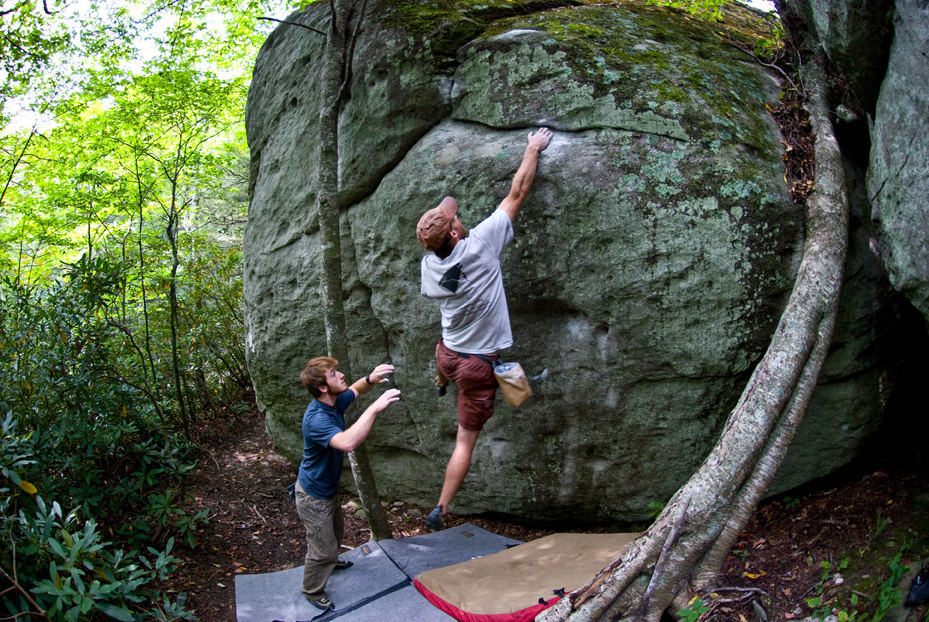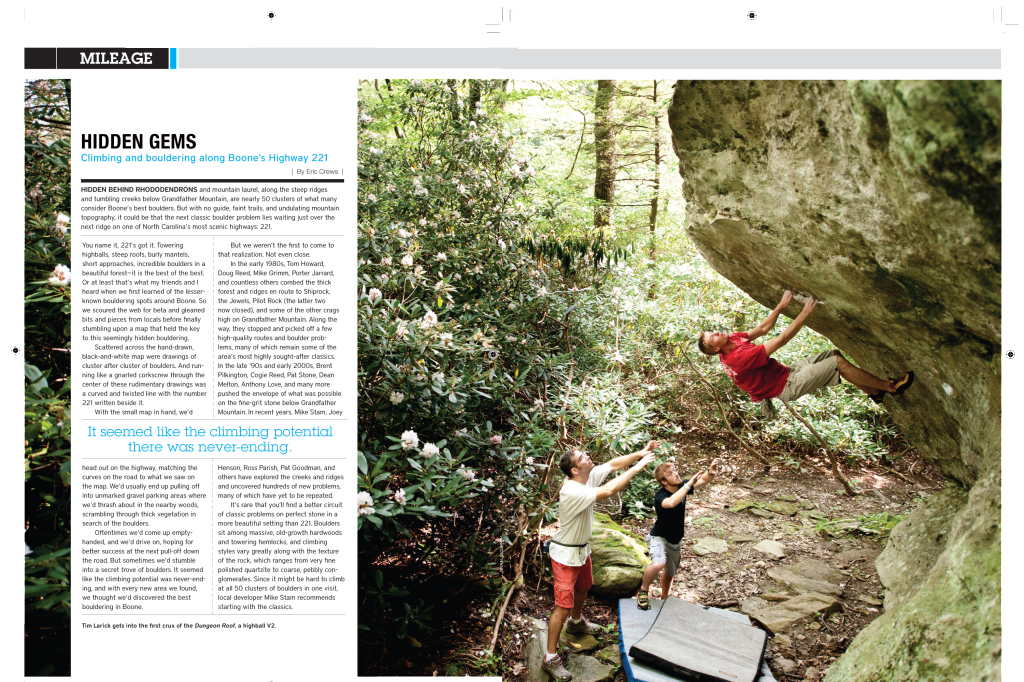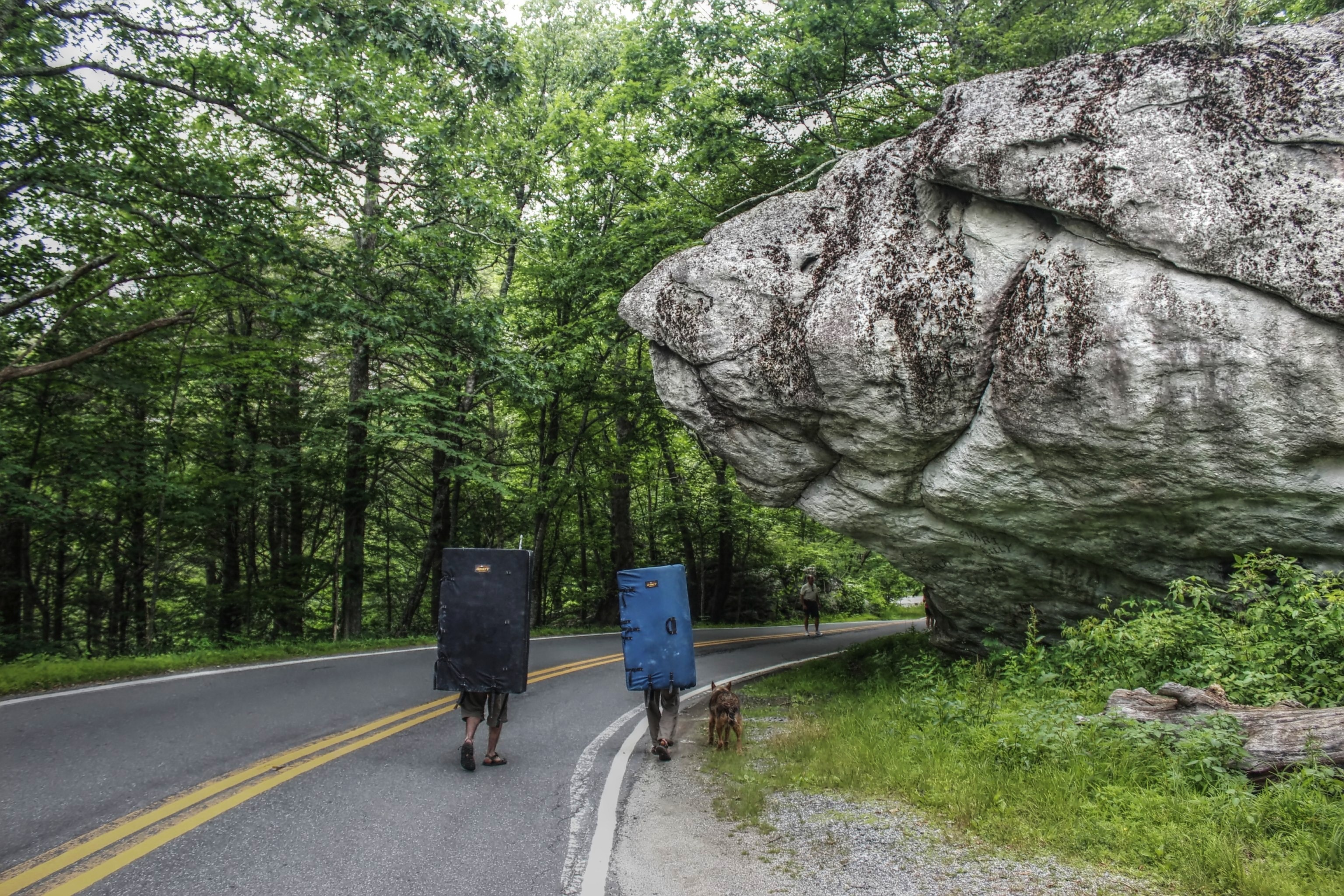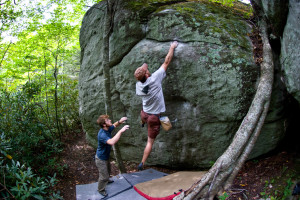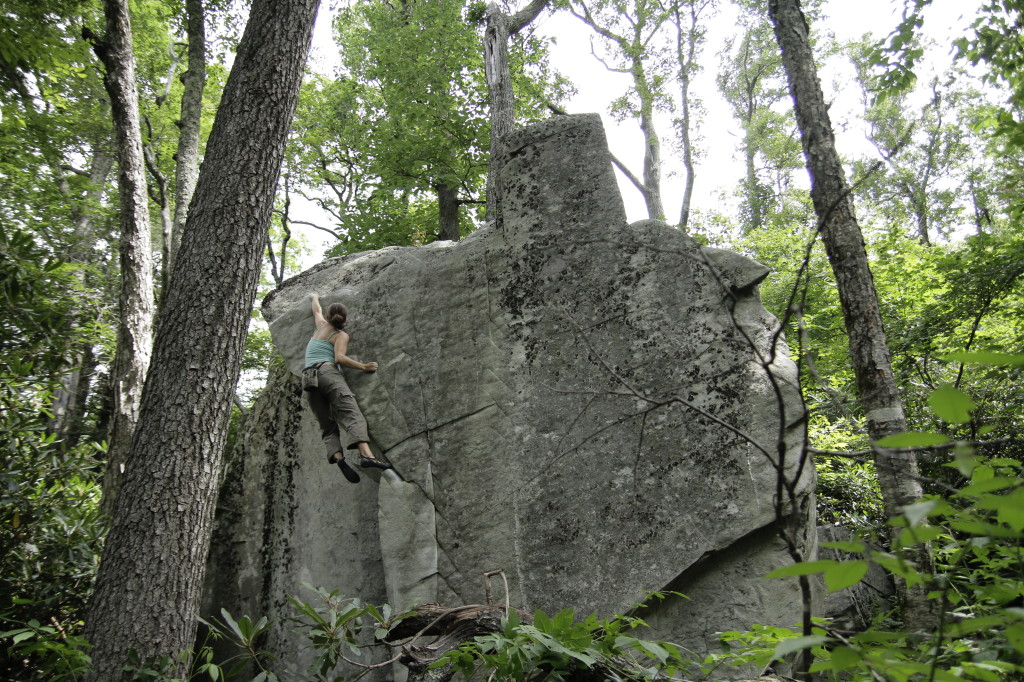The Circuit
GRAFFITI OVERHANG: Just south of Fight Rock (toward Linville) is the Graffiti Overhang, home to What’s Up Arête (V6) and Ominous Roof (V9). What’s Up Arêtefeatures incredible compression climbing out a roof before turning into a juggy arête, with a committing topout: a grovelly roll-over that requires an attentive spot and some good foam. The arête’s big brother, Ominous Roof, can be easily campused if you are James Litz, but for the mere mortals among us, tricky beta is often the key to success.Start out at Fight Rock, the massive boulder that overhangs 221 in the heart of the circuit; this is home to Doug Reed’s bold solo of a 35-foot-tall crack with an imposing topout. To reach Fight Rock, take 221 from Grandfather Mountain State Park’s entrance near Linville. Wind around the curvy highway, beneath the Blue Ridge Parkway, and look for Fight Rock on the left (it can’t be missed).
THE DUNGEON: Directly across the road from Fight Rock is the Dungeon, a 40-foot-long boulder with a handful of great problems. Start by airing it out on theDungeon Roof, an exhilarating V2 that features a committing jump move in the middle and an easy but sometimes-tricky mantel 20 feet off the deck. Head up the hill and locate a jug-fi lled arête that features another fun topout before jumping onCogie’s Problem (aka Sign of the Times), a V5 that offers some tough pulling on small pockets before getting into the best sloper-slapping action around. FourHorsemen of the Apocalypse (V7) and the Green Dragon (V9) are both located just downhill of the Dungeon Roof.
THE CUBE: Climb out of the Dungeon and head for the Cube by hiking back across the road to Fight Rock and up a grassy roadbed, which was used during the construction of the nearby Viaduct on the Blue Ridge Parkway. Walk for about a half-mile until you see a small scree field to your right. (If you make it to the parkway, you’ve gone too far.) Bust right on a faint trail and head uphill toward the boulders. The Cube is a freestanding block that hosts a fun range of V3s to V7s, but beware the coarseness of this boulder. Its pebbly conglomerate has been known to rob climbers of their skin. Just downhill from the Cube is Weigh the Scales (V8). While most of 221 favors climbers who have mastered their technique, strength seems to win on this problem nearly every time.
THE ICEBERG: Highway 221’s infamous, overhanging Iceberg Boulder looms large just a few hundred feet below the Blue Ridge Parkway, hidden just out of sight. Perfect crimps and wide edges are evenly spread across the 20-foot-tall wall with a juggy topout. On the opposite side, you’ll find West Texas, a perfect shape of its namesake state. At over 20 feet tall—and with a high crux that makes climbers either commit or crumple—this might be the proudest V2 in the state. Round out the session by tackling the five other classic problems on this boulder, including the uberclassic Cocaine Highway, aka Central Texas (V6).
BOULDER’S BOULDER: From the Iceberg, walk north (toward Blowing Rock) for 200 yards to reach the Black Top Boulder. A handful of decent problems can be found here, but better options exist 200 hundred yards further through a jumbled scree field at Boulder’s Boulder. With an 18-foot-tall quartzite face full of slopey horizontals and crimpy quartz patina on one side, and the high-quality slopers on the other, this block is what bouldering in the High Country is all about. The 10 problems on this boulder range from V1 to V7. Be sure to bring a stack of pads, as the towering topouts can be intimidating.
THE CARJACKER BOULDER: From Boulder’s Boulder, veer north down a good trail to the Carjacker. This block is tucked away in a lush grove of ferns and hemlocks. The boulder gets its name from local Pat Goodman’s use of a car jack to trundle loose rock that once obstructed the topout of Carjacker Arête (V3). This area features about 15 fun problems, with Carjacker Arête being one of the most aesthetic problems in the entire field. To return to 221, head back to Boulder’s Boulder and walk straight downhill.
M1: If you still have the gumption, make a beeline for the large gravel pull-off straight downhill from Boulder’s Boulder (a quarter-mile north from Fight Rock) and down a well-worn trail to the M1 Boulder. The first problem you’ll see is the namesake M1 problem, a V4 with small holds out a roof, steep jugs, and a reachy move before a mantel 15 feet above your pad. Just to the left of M1 is Instinct (V8). Jump-start to two crimps before pasting feet and hucking a dyno to finish on the topout of M1.
The Beta
BEFORE YOU CLIMB: Most locals will tell you to get things started by slamming back a few shots of java at Espresso News in downtown Boone. Here, climbers hash out their daily plan before heading next door to Footsloggers to resupply on chalk, gather beta from the local guides, and rent an extra crashpad for that highball project. Then it’s time to hit the highway.
GETTING THERE: From Boone, head south on Highway 105 for about 17 miles to the small town of Linville. Turn left onto US-221 and drive about fi ve miles to Fight Rock and the heart of the 221 circuit.
CLIMATE: Good year-round, but Boone is best in early fall when cool temperatures zap the usually thick humidity of the South and bring primo conditions to the High Country. Spring and summer can be rainy, but 221 dries quickly. Winter conditions vary based on snowfall totals, but most years allow for nearly non-stop climbing at the mostly south-facing bouldering zones.
CAMPING: Nearby Price Park Campground on the Blue Ridge Parkway offers amenities at a reasonable rate, but caters to the RV set. Primitive car camping can be found at the “wooden post campground” on 221, located between the Dump and Fight Rock. In neighboring Foscoe, the Grandfather Mountain Campground offers reasonable rates, with showers, and convenient access to grocery stores and Boone, a college town with a penchant for cold beer and live music. The Boone Saloon on King Street offers great food, cold beer, and a good atmosphere for rehashing the day’s sends.
GUIDEBOOK: The High Country Cragger, by Mike Grimm (available at Footsloggers), covers most of the roped climbing areas in the Boone area. Detailed route descriptions, access directions, and hand-drawn topos make this book a must-have for the visiting climber. While there is no guidebook for the area’s bouldering circuit, many locals are usually happy to give visitors a tour of the area’s classics.

